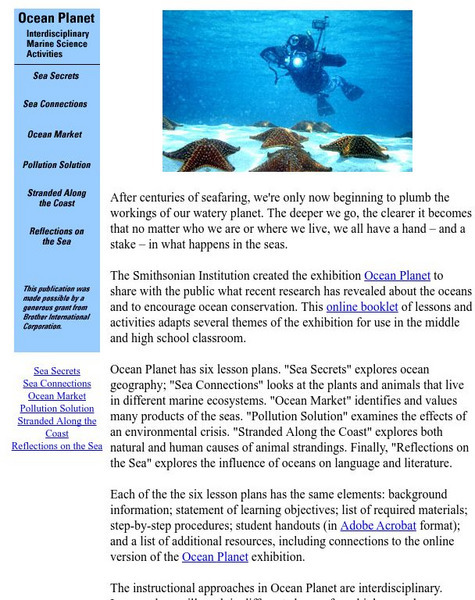Other
Nrc: Unit 2 the Uses of Radiation
A lesson plan on the uses of radiation in science, industry, and medicine. Gives many household examples of how radiation is used. Students will also learn about the NRC's role in regulating radioactive materials.
Alabama Learning Exchange
Alex: Animal, Insect, and Bird Classification
As a follow-up to a unit on the classifications of animals, insects, and birds, students will attend a distance learning field trip. The students will then e-mail trusted adults some of the information learned about the classification of...
Louisiana Department of Education
Louisiana Doe: Louisiana Believes: English Language Arts, Grade 10: Henrietta's Dance
Students consider the importance of leaving a legacy and the myriad ways that we can leave a legacy, through our language, our families, or even our cells. Students also explore the issue of ownership and ethics of medical research. This...
Smithsonian Institution
Smithsonian: Ocean Planet: Interdisciplinary Marine Science Activities
Smithsonian Institution presents ?Ocean Planet: Interdisciplinary Marine Science Activities?. Through this series of six interdisciplinary lessons, students will look at such things as the organisms in different marine ecosystems, the...
Alabama Learning Exchange
Alex: Biodiversity: Local Ecosystem & Food Web
This is a hands on lesson in which students will explore their local community to identify living things. It can be used as part of a unit on biodiversity and energy transfer within a biology, zoology, or environmental science course, or...
University of Arizona
University of Arizona: Pulse: Striding Into the Future: Clinical Trials
An interdisciplinary unit teaching the topic of scientific research performed on human subjects for a skin cancer study. The physics principles behind imaging techniques, the biological implications of UV radiation on the skin, the...
Alabama Learning Exchange
Alex: Pass It Down
This lesson, Pass It Down, integrates science and math into two consecutive hands-on genetics activities that should be embedded within an existing genetics unit suitable for biology young scholars. The results of each activity will be...
Alabama Learning Exchange
Alex: The Circles of Life
This is an inquiry based cooperative learning unit that can be used in biology as a graduation exam review or in botany for a nine week project. The students will learn the life cycle of mosses, ferns, gymnosperms and angiosperms. The...
Alabama Learning Exchange
Alex: Can You Curl Your Tongue?
This lesson is adapted from a Connected Mathematics Unit, How Likely is It? This investigation introduces biology as a source of applications for probability. In this lesson, Curling your Tongue, students determine how many students in...
Scholastic
Scholastic: Cave Animals
Learn more about cave dwellers when you visit this educational resource. This site features useful websites, photographs, fun facts and more.
Other
Adopt a Pond Wetland Curriculum Resource
The Adopt-A-Pond Program was created by the Toronto Zoo for teachers looking for a guide to wetland issues and resources.
Other popular searches
- Biology Unit Test
- Biology Unit Plans
- Plant Biology Unit Plans
- Biology Unit 1
- Biology Unit 3
- Biology Unit Cell
- Biology Unit 1 Review
- Biology Unit Classification
- Biology Unit Lesson Plan
- Biology Unit With Fiction
- Ib Biology Unit Plans
- Biology Unit (Ecology)










